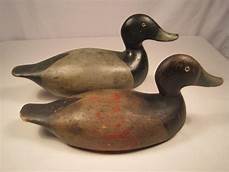A Decoy Corner Article
By Bruce Urben, WWA President

Realistic Decoy Co. Bluebill
Wisconsin was not a hotbed of factory decoy makers like Michigan (Mason decoys) or Mississippi (Pascagoula decoys). But, there were several entrepreneurs in Wisconsin that are worth documenting. One such factory was located in Kewaunee, WI and named Realistic Decoy Company.
William F. Dishmaker, the founder of Realistic Decoy Co. was born on October 18, 1874 on a farm near Casco, WI. Willy (as he was known) worked on the family farm until he turned 18 and moved to the “big city” of Kewaunee where he took a job as a clerk in a local store. Willy had two brothers, Fred and Anton, who founded a farm implement business also in Kewaunee County.
In 1898 Willy married Vlasta Janda and together they had two sons, Gordon and Willard. Both sons were successful dentists!

Realistic Decoy Co. Canvasback
Willy lived most of the remainder of his life in a house on Milwaukee Street in Kewaunee. He had a small carving shop in the basement of his house. He started carving a few decoys for friends and local hunters, as well as several rigs for his own use. Willy was an avid waterfowler, hunting Lake Poygan and Green Bay exclusively. Evidently, Willy learned some of his woodworking skills from his brother, Anton. Together they built several large boats and skiffs.
Neither of Willy’s sons were interested in woodworking, decoy carving or sharing his hunting interests. His grandson, Bill Jr., did however spend time watching Grandpa carve and became an avid waterfowler himself.
In 1934, Willy made a boat for Bernie (BJ) Lendved, the Manager of the Kewaunee Telephone Exchange and they soon became good friends. Before long, Bernie was carving decoys with Willy and shortly thereafter a partnership was formed – Realistic Decoy Company.

Realistic Decoy Co. Canvasback
Willy and Bernie initially sold decoys to local hunters and to several commercial sport shops, including Bertrands Sporting Goods in Green Bay and Gordon Bent Sporting Goods.
Being a partner with Bernie allowed Willy to have access to used cedar telephone poles, which they used for their decoy bodies. They used basswood for the heads, which were mortised into the body. All of their decoys were made by hand, very few power tools were used and no duplicating lathes were employed. Their decoys were all flat bottomed, which reduced roll in the big water. It has been reported that Realistic Decoy Co. did employ several additional carvers, including Alois Lukes and Lloyd Hessel. Willy was responsible for most of the painting on the decoys and he used very realistic colors and shading. However, both he and Bernie worked together to produce the final product.

The bottom of a Realistic Decoy Co. decoy
Realistic Decoy Co. made canvasback, bluebill and mallard decoys in two sizes. Their total output was thought to be less than several thousand decoys. Most, if not all, of the decoys were stamped on the bottom in red ink with “The Realistic Decoy Co.-Kewaunee, Wis”.
Willy and his associates carved decoys for the Realistic Decoy Co. from 1934-1950 when this cottage industry came to an end. Willy continued to carve decoys, however, until his death at his home in January, 1957.
Considering the relatively small number of decoys produced, Realistic decoys are highly regarded by Wisconsin collectors. Realistic decoys can be found on the secondary market and some have been sold for hundreds of dollars!
The Realistic Decoy Co., another example of a Wisconsin original carver, entrepreneur and waterfowler helping shape Wisconsin waterfowling history.
